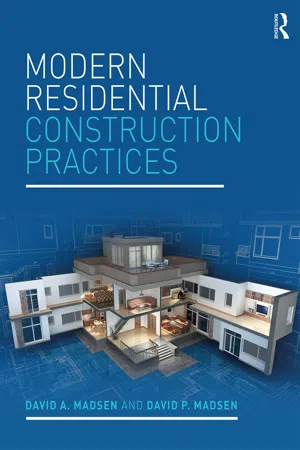
- 526 pages
- English
- ePUB (mobile friendly)
- Available on iOS & Android
Modern Residential Construction Practices
About this book
Modern Residential Construction Practices provides easy-to-read, comprehensive and highly illustrated coverage of residential building construction practices that conform to industry standards in the United States and Canada.
Each chapter provides complete descriptions, real-world practices, realistic examples, three-dimensional (3D) illustrations, and related tests and problems. Chapters cover practices related to every construction phase including: planning, funding, permitting, codes, inspections, site planning, excavation, foundations and flatwork, floors, walls, roofs, finish work and cabinetry; heating, ventilating, and air conditioning (HVAC); electrical, and plumbing. The book is organized in a format that is consistent with the process used to take residential construction projects from preliminary concept through all phases of residential building construction.
An ideal textbook for secondary and college level construction programs, the book is packed with useful features such as problems that challenge students to identify materials and practices, along with research and document information about construction materials and practices, useful summaries, key notes, a detailed glossary, and online materials for both students and educators.
Frequently asked questions
- Essential is ideal for learners and professionals who enjoy exploring a wide range of subjects. Access the Essential Library with 800,000+ trusted titles and best-sellers across business, personal growth, and the humanities. Includes unlimited reading time and Standard Read Aloud voice.
- Complete: Perfect for advanced learners and researchers needing full, unrestricted access. Unlock 1.4M+ books across hundreds of subjects, including academic and specialized titles. The Complete Plan also includes advanced features like Premium Read Aloud and Research Assistant.
Please note we cannot support devices running on iOS 13 and Android 7 or earlier. Learn more about using the app.
Information
Chapter 1
Introduction to building codes and the preliminary construction process
Learning objectives
- ▶Explain the basic fundamentals and terminology of residential building codes.
- ▶Discuss the responsibilities of a licensed Registered Architect (RA), Professional Engineer (PE), and General Contractor (GC).
- ▶Describe the process for obtaining a building permit.
- ▶Explain zoning.
- ▶Discuss private restrictions including deed restrictions; and covenants, conditions, and restrictions (CC&Rs).
- ▶Describe the different ways to create home plans.
- ▶Discuss the option of being a homeowner general contractor.
- ▶Explain the responsibilities and licensing requirements of a general contractor and subcontractors.
- ▶Define construction loan and describe the construction loan process.
- ▶Find a description of materials form and start filling out the basic introductory information.
- ▶Identify a typical cost estimate format for residential construction.
- ▶Give an example of a typical inspection schedule for residential construction.
- ▶Identify voluntary inspections and tests that can be performed on a residential construction project.
- ▶Create PowerPoint presentations related to building codes and preliminary construction processes.
- ▶Answer questions related to building codes and preliminary construction processes.
Introduction
Note
Introduction to building codes
Note
- ▶International Building Code
- ▶International Residential Code for One- and Two-Family Dwellings
- ▶International Mechanical Code
- ▶International Plumbing Code
- ▶International Fire Code
- ▶International Fuel Gas Code
- ▶International Energy Conservation Code
- ▶International Existing Building Code
- ▶International Wildland-Urban Interface Code
- ▶ICC Performance Code for Buildings and Facilities
- ▶International Property Maintenance Code
- ▶International Zoning Code
- ▶International Private Sewage Disposal Code
- ▶International Green Construction Code
- ▶International Swimming Pool and Spa Code
Creating the codes
Q&A
PowerPoint
Note
Table of contents
- Cover
- Title
- Copyright
- Contents
- Preface
- Learning Modern Residential Construction Practices
- Instructor resources
- Authors
- Acknowledgements
- 1. Introduction to building codes and the preliminary construction process
- 2. Introduction to green building technology
- 3. Drawings and specifications
- 4. Construction site and excavation
- 5. Foundation materials and construction
- 6. Floor framing materials and construction
- 7. Wall framing materials and construction
- 8. Roof framing materials and construction
- 9. Insulation and barriers
- 10. Door and window specifications and installation
- 11. Stair construction
- 12. Fireplace construction
- 13. Mechanical, plumbing, and electrical systems
- 14. Indoor air quality and safety
- 15. Finish work and materials
- Glossary
- Index